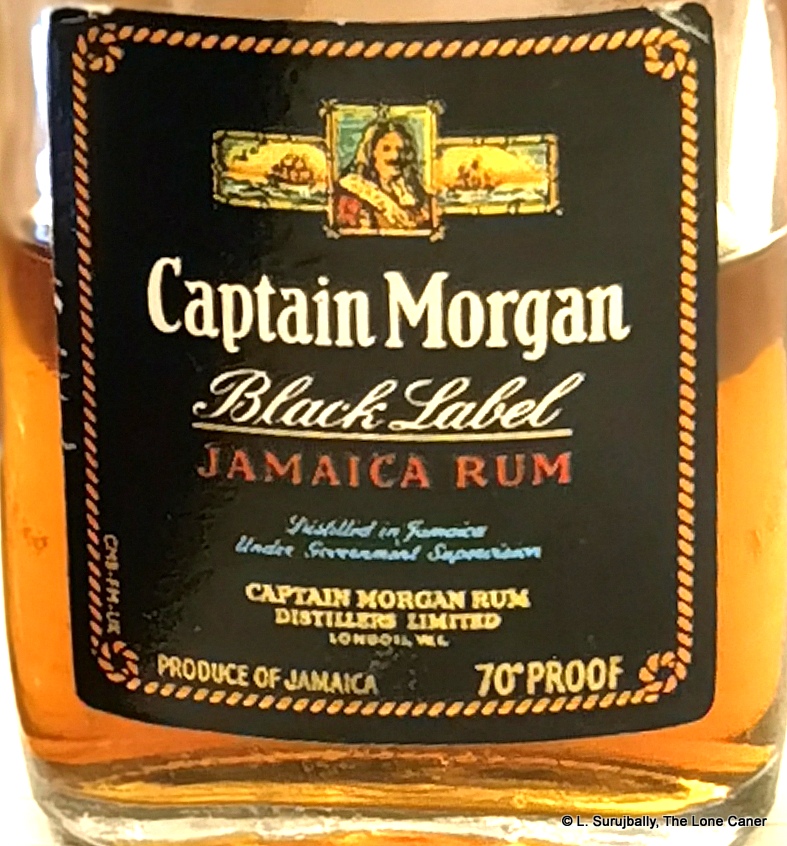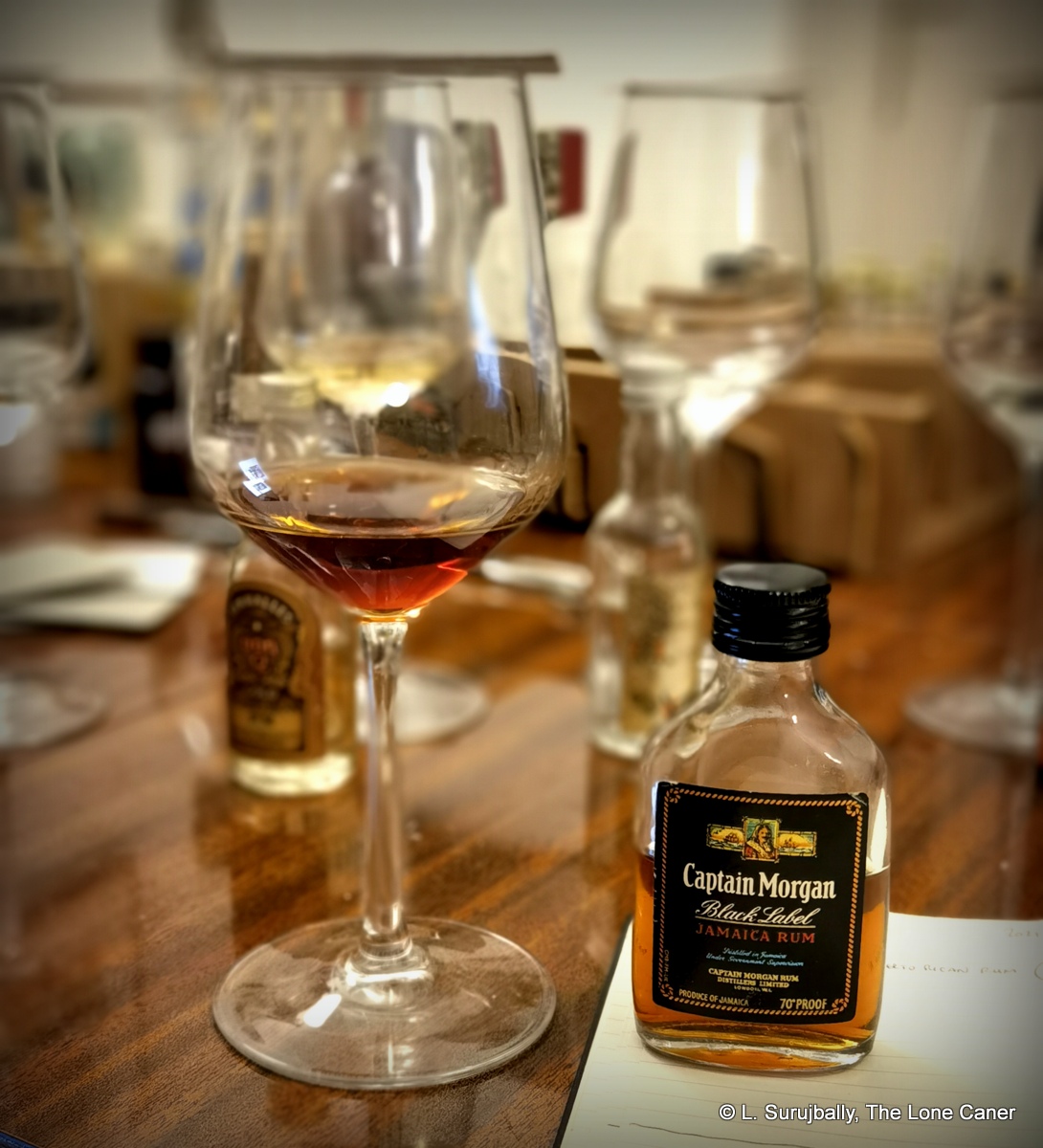Captain Morgan was not always the dismissed and derided global rum-killer which has been its lot since it nose-dived into a vat of overspiced and insipid distillate where Diageo put it. But the original spiced-rum recipe — which Samuel Bronfman of Seagram’s bought from the local Jamaican pharmacy of the Levy brothers in 1944 when he had bought the Long Pond Distillery — long predated Diageo’s acquisition. It’s just that Seagram never made it the centrepiece of the brand the way Diageo did.
For a long time Seagram’s used rums from around the Caribbean to make blends under various brand names (see other notes, below). The Black Label rum looked at here, for example, was a Jamaican rum — we can assume from Long Pond — and there are other now-discontinued variations such as the blend of Jamaica, Guyana and Barbados rums (also under the Black Label brand) made in the early 1980s. In 1984, still owned by Seagram’s, they introduced the “Original Spiced” Captain Morgan rum which soon became enormously popular. So it isn’t all Diageo (or Vivendi, which had merged with Seagram’s a year earlier), and if this Captain Morgan Jamaican rum from the 1970s has been tarted up, well, it’s at least done with a little restraint.
Colour – Amber
Strength – 70º proof / 40% ABV
 Nose – Licorice and coke, into which someone dunked a rusty nail (seriously!); ashy and minerally notes which are only partly ameliorated by rather bitter coffee grounds, brown sugar and unsweetened chocolate. Some dark fruit like prunes, and a touch of citrus-like lemon peel. There’s even a sense of tomato ketchup on the nose as it opens, but mostly the aromas resemble a low rent Demerara rum than anything else.
Nose – Licorice and coke, into which someone dunked a rusty nail (seriously!); ashy and minerally notes which are only partly ameliorated by rather bitter coffee grounds, brown sugar and unsweetened chocolate. Some dark fruit like prunes, and a touch of citrus-like lemon peel. There’s even a sense of tomato ketchup on the nose as it opens, but mostly the aromas resemble a low rent Demerara rum than anything else.
Palate – Thin, but nice, to be expected at 40%. Again, licorice and coca cola, caramel, brown sugar, some molasses. Some coffee grounds and dark fruit. Rather bland, all in all, buit nice enough, and the slight sweet helps it go down easy.
Finish – Short, light. Brown sugar, blancmange, anise and light molasses. If there’s a fruit in there, it’s hiding.
Thoughts – It’s much more “real” than modern Captains, and surprisingly drinkable. There’s more taste, more heft and a lot less clear additions. For example, I couldn’t sense any vanilla, and the sweetness was borderline, so if had been doctored, it was with a gentle hand and a small spoon rather than a spade.
(78/100)
Other notes
- Age is unknown. Standard practice for such cheap rums is to age them for a few years, more than one and less than five, but that’s unsubstantiated in this case.
- The label is interesting in and of itself. First of all it says that it’s a “product of Jamaica.” That instantly eliminates Diageo as the producer. Secondly, it’s 70º proof – this indicates a pre-1980s dating of a pre-metric age in the Commonwealth, after which the “% ABV” and not “º proof” became the law for labels. Thirdly, it’s made by an outfit called Captain Morgan Rum Distillers in London (Dacre Street SW1H), which, as far as I can ascertain, was the distribution arm in the UK at that time, never mind that they didn’t have a distillery there. The street address is long closed and has been redeveloped into flats, a small hotel, and office space.
- Seagram’s and Vivendi merged in June 2000, with the key point being the joining of their media empires…the spirits business was secondary and Edgar Bronfman noted at the time it would be sold off anyway. A year later the wine and spirits division of Seagram’s was on the block and three conglomerates were in the running to take over the lucrative brand portfolio: an alliance of Brown-Forman and Bacardi, the latter of which at the time was having cash flow issues and was heavily in debt; Allied Domecq; and a partnership of Pernod-Ricard and Diageo. Diageo-PR won the tussle, split the portfolio and Diageo walked away with (among other brands) Captain Morgan, though they had to give up Malibu brand on anti-competitive grounds to do so.
- Distillate — aside from that derived from Long Pond, and other countries’ stocks — was primarily from Puerto Rico. Around 2011, Captain Morgan was induced by massive tax breaks and financial concessions, to build a distillery and make its rums in the US Virgin Islands. Nowadays this is where Captain Morgan brands are made.
- Originally, as noted, Captain Morgan was a blend from Jamaica and other islands. Hugh Barty-King and Anton Massel, in their 1983 book “Rum Yesterday and Today” (p.190), wrote that “There were always 65,000 forty-gallon barrels of rum at the Seagram UK processing plant at Speke, Liverpool, and the storage centre at Huyton. Their supplies came mainly from Guyana and Jamaica, but also in small amounts from Barbados, Hawaii, Mexico and Puerto Rico. The rum was diluted and made up into various blends, put into bottles on which labels were put with such names as ‘Captain Morgan’ (the most in demand), ‘Woods’, ‘Myers’, ‘Old Charlie’ and ‘Tropicana’.”
